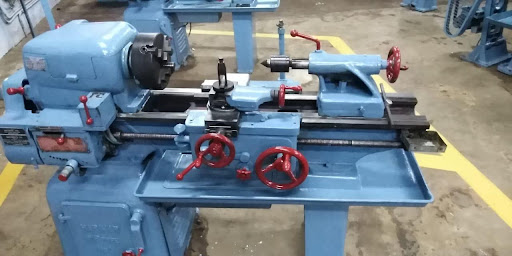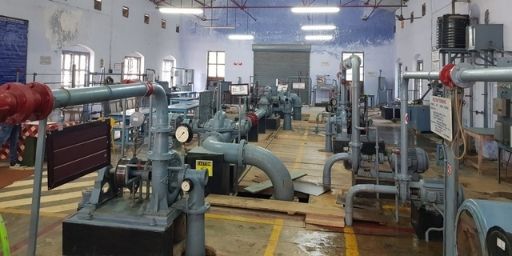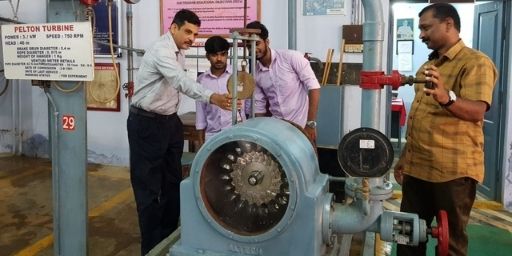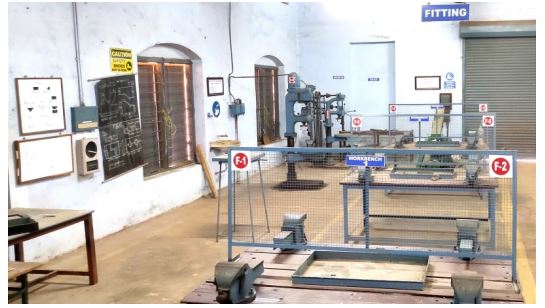






| Fitting | |
|---|---|
| SI No | Name of Equipment |
| 1 | Drilling Machines |
| 2 | Bench Grinder |
| 3 | Power Hacksaw |
| 4 | Work table with 12 bench vices |
| Carpentry | |
| 5 | Band saw |
| 6 | Circular Band saw |
| 7 | Wood turning Lathes |
| 8 | Universal wood working machine |
| 9 | Wood cutting machine |
| 10 | Wood turning Lathes |
| 11 | Work table with 12 Carpenters vice |
| Sheet Metal | |
| 12 | Folding Machine |
| 13 | Shearing machine |
| 14 | Circular cutting machine |
| 15 | Work table with 12 bench vice |
| Smithy | |
| 16 | Forge with Chimney 8 nos |
| 17 | Forging Machine |
| 18 | Shearing Machine |
| Foundry | |
| 19 | Cupola Furnace |
| 20 | Oil fired furnace |
| 21 | Moulding Machine |
| Welding | |
| 22 | 3 Φ AC transformer |
| 23 | Generator type welding machine |
| 24 | Spot welding Machine |
Production Engineering Lab
| Major Equipments | |
|---|---|
| SI No | Name of Equipment |
| 1 | Centre Lathe 18 nos |
| 2 | Drilling Machine |
| 3 | Tool & Cutter Grinder |
| 4 | Milling machines 3 nos |
| 5 | Slotting machine 2 nos |
| 6 | Shaper 5 nos |
| 7 | Planning Machine |
| 8 | Cylindrical Grinder |
| 9 | Power Hacksaw |
ME09 308(P): Production Engineering Lab - I
Course outcomes: on completion of this course, the student must be able to To acquaint with the basics of centre lathe and CNC lathe. To perform on centre lathe and CNC lathe.
| SI. No | Name of Experiment |
| 1 | Study of machine tools and machining processes - specification of machine tools - power sources |
| 2 | Study of centre lathe - general features, parts and functions - different machining operations on centre lathe - turning, taper turning, thread cutting, drilling, boring, reaming, tapping, profile turning, knurling. |
| 3 | Study of tolerances and surface finish - measuring tools and gauges. |
| 4 | Exercises: on centre lathe requiring simple turning, taper turning, knurling, boring and thread cutting |
| 5 | Exercises on centre lathe including multi-start thread, square thread, and internal thread |
| 6 | Study of CNC lathe |
| 7 | Exercises on CNC lathe: Turning, step turning |
ME09 308(P): Production Engineering Lab - II
| Objectives | |
|---|---|
| 1 | To acquaint with basic machine tools |
| 2 | To impart training on shaper, slotting, milling and grinding machines. |
| 3 | Understand the concepts and significance of limits and tolerances in the context of machining operations |
| 4 | To perform machining operations like shaping, slotting, drilling, milling, grinding etc. |
| 5 | Apply the theories in to machining operations like gear cutting |
| 6 | Function effectively as an individual and as a member of ateam |
| Introduction | |
|---|---|
| 1 | Limits, fits and tolerances |
| 2 | Shaping machine-slotting machine - horizontal milling machine - surface, centreless and cylindrical grinding |
| 3 | Spindle drives-milling cutter - indexing head |
| 4 | Simple, compound, differential and angular indexing |
| Study of machines | |
|---|---|
| 1 | Shaper |
| 2 | Planer |
| 3 | Slotting machine |
| 4 | Drilling machine |
| 5 | Milling machine |
| 6 | Grinding machine |
| 7 | Power saws |
| Exercises | |
|---|---|
| 1 | Exercises on shaper and slotting machines - cube with V-groove, slot and guide ways. |
| 2 | Exercise on milling machine-spur gear and helical gear milling by simple and differential indexing, surface milling, slot and key way milling. Exercise on grinding and tool grinding |
Lab in Charge - Dr P R Suresh,Phone : 9495250759, Email : sureshpr101@gmail.com
Instrumentation lab intends to provide knowledge of uncertainties involved in many measurements and to train in the calibration and use of different measuring instruments
| Major Equipments | |
|---|---|
| SI. No | Name of Equipment |
| 1 | Vibration meter |
| 2 | Sound level meter |
| 3 | Air velocity meter |
| 4 | Planimeter |
| 5 | Dynamic stress measurement setup |
| 6 | Bourden tube pressure gauge measurement setup |
| 7 | Tachometer calibration setup |
| 8 | Strain gauge pressure cell calibration setup |
| 9 | Strain gauge load cell |
| 10 | Determination of time constant setup |
| 11 | Autocollimator |
| 12 | Thermocouple calibration setup |
| 13 | Micrometer calibration setup |
| 14 | Stroboscope |
| Objectives | |
|---|---|
| 1 |
a) To provide knowledge of uncertainties involved in any measurement. b) To train the students in the calibration and use of different measuring instruments. c) Comment about uncertainties involved in any measurement d) Calibrate and use of different measuring instruments e) Function effectively as an individual and as a member of a team |
| 2 |
(a) Determination of uncertainties in computed quantities such as the following (1) Volume of a rectangular block or cylinder computed from measurements of length, width, height and diameter (2) Water power computed from measurements of density, local acceleration due to gravity, volumetric flow rate and head (3) Shaft power computed from measurements of speed and torque (4) Electrical power computed from measurements of “number of rotations of energymeter disk”, time taken and “energymeter constant” (b) Selection of instruments for computing quantities with desired uncertainties |
| 3 | Determination of bias and random error of the following instruments by calibrating them using proper standards (1) Load cells such as strain-gauge-load cells, strain-gauge-beam transducer etc. (2) Rotameter (3) Bourdon-tube pressure gauge (4) LVDT (5) Thermocouples (6) Tachometers (7) Constant area flow meters |
| 4 |
(a) Preparation of a psychrometric chart for the laboratory and determination of psychrometric properties of atmospheric air - use of Sling psychrometer (b) Analysis of exhaust gases and flue gases with the help of orsats apparatus, gas chromatograph, paramagnetic oxygen analyser, smokemeter etc. (c) Acoustic measurements: sound level meter-octave band filter- preparation of noise contours (d) Plotting of velocity profiles using pitot tubes and hot wire anemometers |
| 5 | Study of, and making measurements with: Water meter, velometers, pH meter, slip gauges, comparators, planimeter, pyrometers, RTDs, thermistors, CRO, multimeters, linear capacitance meters & LDR (light depended resistance) |
| 6 | Determination of static and dynamic characteristics of zero, first and second order instruments |
Lab in Charge- Dr.Shaji Mohan B,Phone: 9446944397,Email: shajimohanb@rediffmail.com
Heat engines lab strengthens the knowledge on IC engines, Blowers and Compression. It also equips students to carryout independent experiments, analysis and infer results
| Major Equipments | |
|---|---|
| SI No | Name of Equipment |
| 1 | LISTER DIESEL ENGINE |
| 2 | RUSTON DIESEL ENGINE |
| 3 | KRIMO DIESEL ENGINE |
| 4 | KIRLOSKAR 10HP DIESEL ENGINE |
| 5 | KIRLOSKAR TWIN CYLINDER DIESEL ENGINE |
| 6 | KIRLOSKAR 5HP DIESEL ENGINE |
| 7 | ANIL DIESEL ENGINE |
| 8 | PERKINS P4 DIESEL ENGINE |
| 9 | KIRLOSKAR 4 STROKE DIESEL ENGINE CUT MODEL |
| 10 | AMBASODOR PETROL ENGINE |
| 11 | FIAT PETROL ENGINE |
| 12 | VARIABLE COMPRESSION ENGINE |
| 13 | WHOLSELY PETROL ENGINE |
| 14 | ENFIELD PETROL ENGINE |
| 15 | BAJAJ PETROL ENGINE |
| 16 | TWO STAGE RECIPROCATING AIR - COMPRESSOR |
| 17 | CENTRIFUGAL BLOWER |
| 18 | VAPOUR COMPRESSION REFRIGERATION TEST RIG |
| 19 | VAPOUR COMPRESSION AIR-CONDITIONING TEST RIG |
| 20 | FLASH AND FIRE APPARATUS |
| 21 | REDWOOD VISCOMETER - No.2 |
| Objectives | To strengthen the knowledge onheat engine, and heat transfer principles through lab experiments. To equip the students to carry out independent experiments, and to train them to analyse, report and infer the results |
| Course outcomes | On completion of this course, the student must be able to a) To perform test on IC engines and plot performance characteristics of petrol and diesel engines and valve timing diagram. b) To determine viscosity, flash and fire point and calorific value of the fuel. c) To determine emissivity, thermal conductivity and convective heat transfer on various metals. d) Function effectively as an individual and as a member of a team. |
| Experiments | |
|---|---|
| 1 | Study of systems of petrol and diesel engines |
| 2 | Study of automotive parts |
| 3 | Test on IC engines: a)Constant speed performance characteristics of petrol and diesel engines b)Valve timing diagram |
| 4 | Determination of viscosity, flash and fire point and calorific value of the fuel |
| 5 | Heat transfer experiments: a) Emissivity measurement of a radiating surface b) Measurement of solar radiation c) Thermal conductivity of a metal rod d) Measurement of unsteady state conduction heat transfer e) Experimental study on forced convection heat transfer |
| Objectives |
a) To strengthen the knowledge onheat engines, and heat transfer principles through advanced experiments. b) To equip the students to carry out independent experiments, and to train them to analyse, report and infer the results. |
| Course outcomes | On completion of this course, the student must be able to a) To perform test on IC engines and determine friction power, analyze the exhaust gas of IC engine. b) To analyze the heat exchange in engines through parallel and counter flow arrangements. c) To perform test on air compressor, blower and on refrigeration plant. d) Function effectively as an individual and as a member of a team |
| Experiments | |
|---|---|
| 1 | Test on IC engines a) Variable speed performance test on petrol and diesel engines b) Determination of friction power - retatrdation test and morse test c) Study of the effect of cooling water on engine performance d) Heat balance test e) Analysis of the exhaust gas of IC engines |
| 2 | Heat transfer experiments a) Performance studies on a shell and tube heat exchanger b) Performance studies on parallel and counter flow arrangements in a concentric pipe heat exchanger |
| 3 | Performance tests on air compressor and blower |
| 4 | Performance test on refrigeration plant |
Lab in Charge - Dr Rajeev N, Phone : 9633694538, Email : rajeevmaliyil@gmail.com
Hydraulics machines lab strengthens the knowledge of hydraulic machinery through lab experiments. It also helps in analyzing the performance characteristics of turbines and pumps.
| Major Equipments | |
|---|---|
| No | Name of Equipments |
| FLUID MACHINES LAB | |
| 1 | Pelton Turbine |
| 2 | Francis Turbine |
| 3 | Kaplan Turbine |
| 4 | Constant speed centrifugal pump |
| 5 | Variable speed centrifugal pump |
| 6 | Multistage centrifugal pump |
| 7 | Reciprocating Pump |
| 8 | Gear Pump |
| 9 | Hydraulic Ram |
| 10 | Stage Pump |
| 11 | Reciprocating Pump with Dual discharge |
| 12 | Gear Pump Demonstrating model |
| 13 | Working models of Turbines & Pumps |
| Fluids lab | |
| 1 | Darcies Coefficient |
| 2 | Triangular Notch |
| 3 | Rectangular Notch |
| 4 | Metacentric Height |
| 5 | Venturimeter |
| 6 | Orifice meter |
| 7 | Time of emptying method |
| 8 | Hydraulic coefficient |
| Objectives | To strengthen the knowledge on fluid mechanics principles, and hydraulic machinery through lab experiments To equip the students to carry out independent experiments, and to train them to analyse, report and infer the results |
|---|---|
| Course outcomes | On completion of this course, the student must be able to To analyze the mechanism of chip formation and properties affecting during machining. To distinguish various types of machining operations and explain the parameters used in each. To describe the advanced machining processes and outline its formulation and economics. To differentiate various types of forming and punching operations and explain about in detail. To collect the basics on theory of machine tools. |
| SI No | Name of Experiment |
|---|---|
| 1 | Study of plumbing tools and pipe fittings |
| 2 | Measurement of metacentric height and radius of gyration of floating bodies |
| 3 | Measurement of viscosity of fluids |
| 4 | Study of discharge measuring instruments |
| 5 | Measurement of pressure and velocity |
| 6 | Calibration of venturimeter, orifice meter, notches and weirs, nozzle meters, and rotameters |
| 7 | Pipe friction - minor losses in pipes - verification of Bernouli’s theorem |
| 8 | Experiment on flow through open channels - venturiflume |
| 9 | Demonstration of forces on curved and plane surfaces |
| 10 | Evaluation of torque & performance of turbines - operating characteristics - Muschel’s curves |
| 11 | Performance of pumps: Centrifugal pumps, Reciprocating pumps, Gear pumps, Hydraulic ram, Torque converter. |
Lab in Charge - Dr. Sudeep U, Phone : 9446561488,Email : usudeep@gmail.com
Heat transfer lab strengthens knowledge on conduction, convection and radiation heat transfers through experimentation
| Major Equipments | |
|---|---|
| 1 | Composite wall apparatus |
| 2 | Thermal conductivity apparatus |
| 3 | Forced convection apparatus |
| 4 | Free convection apparatus |
| 5 | Emissivity apparatus |
| 6 | Pin fin apparatus |
| 7 | Parallel flow heat exchanges |
| 8 | Counter flow heat exchanges |
| Experiments done in Heat Transfer Lab | |
| 1 |
Heat transfer experiments a) Performance studies on a shell and tube heat exchanger b) Performance studies on parallel and counter flow arrangements in a concentric pipe heat exchanger |
Lab in Charge- Dr K S Suresh, Phone : 9446564308, Email : sureshsethu@rediffmail.com
CAD lab trains the students in solid modelling, static & dynamic analysis and computer controlled manufacturing methods
| Major Equipments& Software’s | |
|---|---|
| 1 | XL Turn Lathe CNC machine. |
| 2 | CAD/CAM/CAE software’s like : a.) Solid Works b.) CATIA c.) MECHANICA d.) IRON CAD e.) AUTOCAD f.) ANSYS g.) MTAB |
| Objectives | To train the students in solid modelling To practise static and dynamic analyses using FEM |
|---|---|
| Course outcomes | (a>On completion of this course, the student must be able to To practise computer controlled manufacturing methods To perform finite element analysis using software To understand the fundamentals of part programming and programming of industrial robots To understand the theory and concepts of computer aided inspection and quality controls. (b) Function effectively as an individual and as a member of a team |
| List of experiments in CAD/CAM lab | |
|---|---|
| SI No | Name of Experiment |
| 1 | Exercises on solid modeling (12 hours) : Introduction to computer graphics - viewing transformations, curves and surfaces generation, curve fitting and curve fairing techniques - 2D, wire frame, 3D shading - familiarity with Boolean operations - sweep, revolve, loft, extrude, filleting, chamfer, splines etc. - windowing, view point, clipping, scaling and rotation transformations using commercial solid modeling packages |
| 2 | Exercises on finite element analysis (12 hours) : Introduction to FEM - 1D, 2D and 3D elements - shape functions - preprocessing - boundary conditions, structured and free mesh generation - analysis - linear and non linear analysis - static and dynamic analysis - post processing - display, animation, extraction of nodal data - exercises on heat conduction and elasticity may be given using commercial FEM packages |
| 3 | Assembly and mechanism design (6 hours) : Assembling of various parts and tolerance analysis - synthesis and design of mechanisms - animations - exercises on various mechanisms like four bar linkages and its variations - cam and follower - two and four stroke engines |
| 4 | Computer aided manufacturing (9 hours) : Part programming fundamentals - manual part programming and computer aided part programming - hands on training in computer controlled turning and milling operations - familiarity with windows based software packages - tool path generation and simulation - exercises on CNC lathe and machining center/milling machines |
Lab in Charge- Dr. Vinod V, Phone : 9447335282, Email : vinodnss@gmail.com
CAD lab trains the students in solid modelling, static & dynamic analysis and computer controlled manufacturing methods
| Test on IC engines |
|---|
| Performance test on engines using biodiesel in CRDI engines. Performance test on engines using alternate fuels in MPFI engines. Variable speed performance test on MPFIpetrol and CRDIdiesel engines. Determination of friction power - retatrdation test and morse test. Study of the effect of cooling water on engine performance. Heat balance test on MPFI/CRDI engines. Analysis of the exhaust gas of IC engines using smoke meter.Performance testing of hybrid engine. |
Lab in Charge- Suresh K, Workshop Superintendent, 9446828114
Fitting Shop
Instructor in Charge : Vimesh Nair K, Instructor Gr I, 9048023688
Staff in Charge : Renjith Kumar C R, Trade Instructor Gr II, 9605363319
Equipment/Facilities
- Drilling Machines – 2Nos
- Bench Grinder
- Power Hacksaw
- Worktable with 12 Bench Vices



